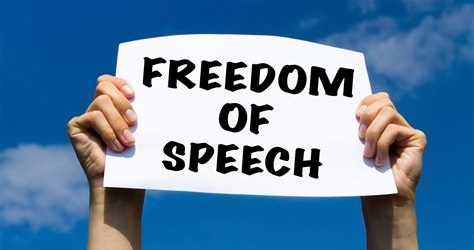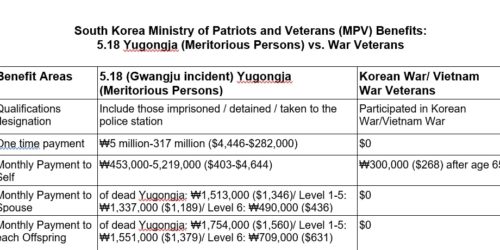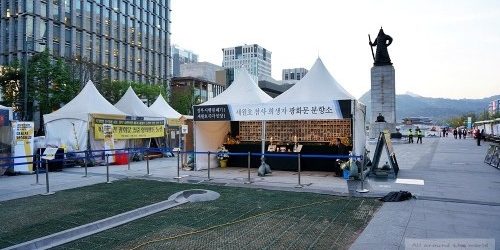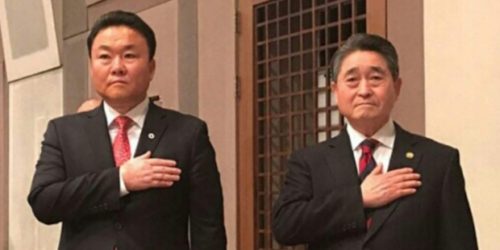[Exclusive] Former Spy Chief Kwon Young-hae “North Korean Intervention in Gwanjgu in May 1980 Confirmed by the Agency for National Security Planning (NSP) [Korea’s CIA]”
2024-6-20, SkyeDaily (허겸, Hur Kyoum) [TRANSLATION]
- Confirmed through secret operations while at the NSP during 1994-1998
- The “Anti-South Korea Operation Heroes Monument” in Chongjin, North Korea is direct evidence
- When the existence of the Tombstone Monument was disclosed in South Korea, it was suddenly moved to a third place.
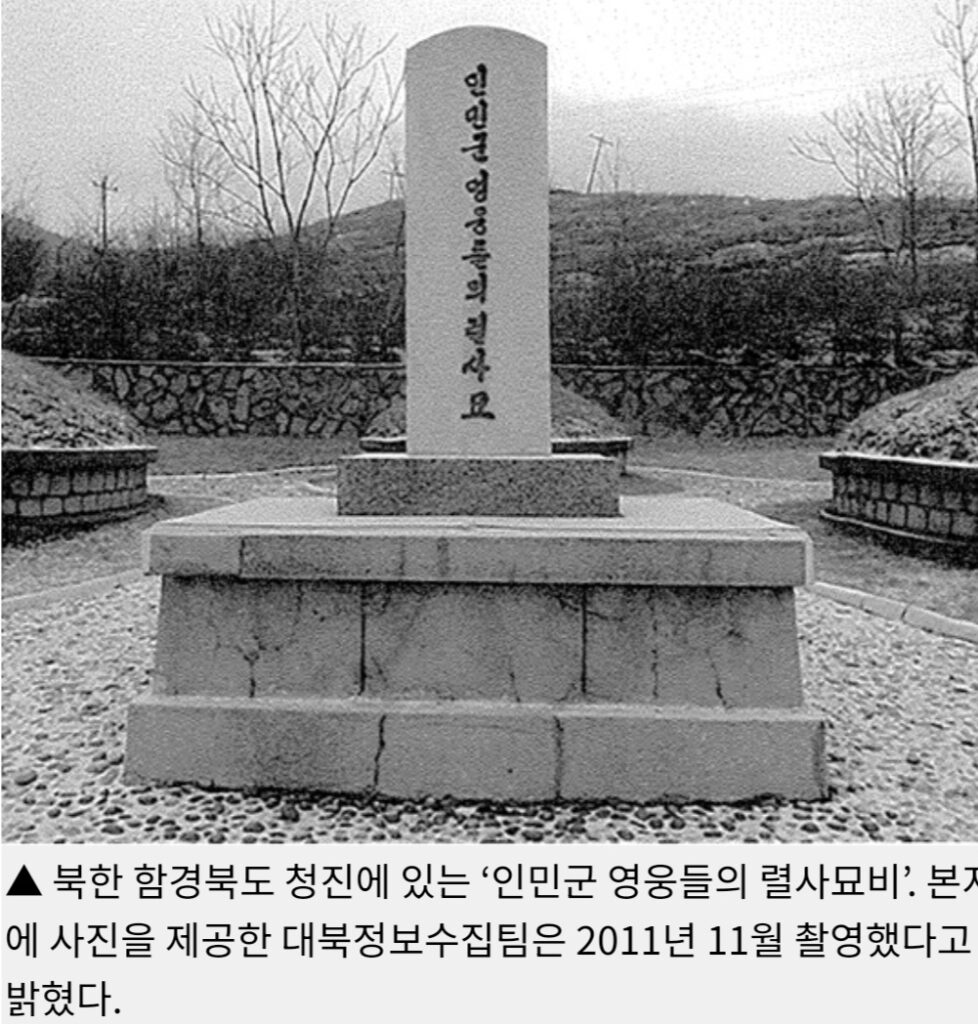
Above: “Korean People’s Army (KPA) Martyred Heroes Tombstone Monument” (인민군 영웅들의 렬사묘비) in Chongjin, North Hamkyung Province, North Korea. The photo was taken in November 2011, according to the ROK team collecting intelligence on North Korea that provided the photo.
For the first time, it is revealed that the Agency for National Security Planning (NSP) (now the National Intelligence Service) had already confirmed North Korea’s involvement in the Gwangju / Kwangju incident of May 1980 [referred to as “5.18” in South Korea] through “secret operations” in the 1990s.
[Note: Retired Colonel Jee Man-won has been in prison since January 2023 for stating that North Korean special forces were involved in the Gwangju incident in May 1980. See here and here.]
Kwon Young-hae (권영해) (87, pictured), a former director of NSP, recently met with Sky eDaily and revealed, “Our government directly confirmed North Korea’s involvement in the Gwangju incident [in May 1980] when I was the head of the intelligence agency.”
This is the first time that a former intelligence agency chief has made a confirmatory statement about North Korea’s involvement in the Gwangju incident in 1980.
Kwon, who served as Minister of National Defense in 1993 and Director of NSP from 1994 to 1998, is the highest-ranking government official to testify about North Korea’s involvement in the Gwangju incident.

Kwon Young-hae, former NSP Chief
He served as the head of the NSP during the Kim Young-sam and Kim Dae-jung administrations. This period was around the time when the social evaluation of the Gwangju incident changed drastically from riots / insurrection to a democratization movement, and suspicions were steadily raised that former director Kwon was involved in the Kim Young-sam government’s fabrication of evidence [to label it a “democratization movement,” rather than riots] as the head of the intelligence agency.
[Note: When the political slush fund paid to Kim Young-sam from Rho Tae-woo was about to be exposed, Kim decided to distract by diverting attention to another matter—turning what the court already referred to as the “Gwangju Riots” into the “Gwangju Democratization Movement.” In the process, multiple special laws were passed, applicable retroactively, which led to the trials of former officials of the Chun Doo-hwan administration, including presidents Chun Doo-hwan and Rho Tae-woo, and gave lavish and extensive benefits to those designated as “5.18 Meritorious Persons” and their families, creating a patronage to this day. This “5.18 Meritorious Persons” list continued to grow into thousands, including those who were not even born at that time. The list greatly expanded in the Moon Jae-in administration. See here for these benefits.]
For this reason, this interview is regarded as his first declaration of conscience.
Due to the suspicions raised against Kwon and the atmosphere of the times, he has never directly mentioned North Korea’s involvement in the Gwangju incident in public or in media interviews until now.
However, as he confessed for the first time in an interview with this newspaper that our agents had personally confirmed North Korea’s involvement in the Gwangju incident when he was the NSP head, attention is now focused on whether he will make further revelations in the future
Kwon met with this reporter immediately after a political party event held in Seoul on June 17, 2024, and made a shocking revelation, saying, “I personally confirmed North Korea’s involvement in the Gwangju incident through secret operations when I held the (NSP Director) post.”
He declined to comment on the method and manner of the operation, saying that it was “the innate work of the intelligence agency,” but stated that “the Memorial Tombstone of [North Korean agents sent to South Korea to conduct anti-South Korea operations) Heroes in Chongjin, North Korea is a fact.”
Former director Kwon stated, “(When the existence of the monument became known in South Korea), [North Korea] changed its location and hid it in a 3rd location” and reiterated that the connection between the monument and North Korea’s involvement in Gwangju was “true and I have confirmed it.” The 3rd location is not in northeastern North Korea.
Regarding the timing of the verification, he emphasized the fact that he verified it when he was the head of the intelligence agency, saying, “I was trying to confirm it because it appeared in North Korean textbooks, and I cannot specify the source.”
He said, “When we found out that (the Tombstone Monument) was in Chongjin because (its existence) appeared in North Korean textbooks, we moved to verify it,” adding, “However, since they were secret operations, we could not confirm that it was verified by (our) intelligence agencies, so it was treated as if it were provided by North Korean defectors.”
He did not say whether he had reported the results of the operation to the then president. The later part of his term overlaps with the People’s Government (Kim Dae-jung administration). The 15th president Kim Dae-jung was inaugurated on February 25, 1998, and Kwon served until March of that year.
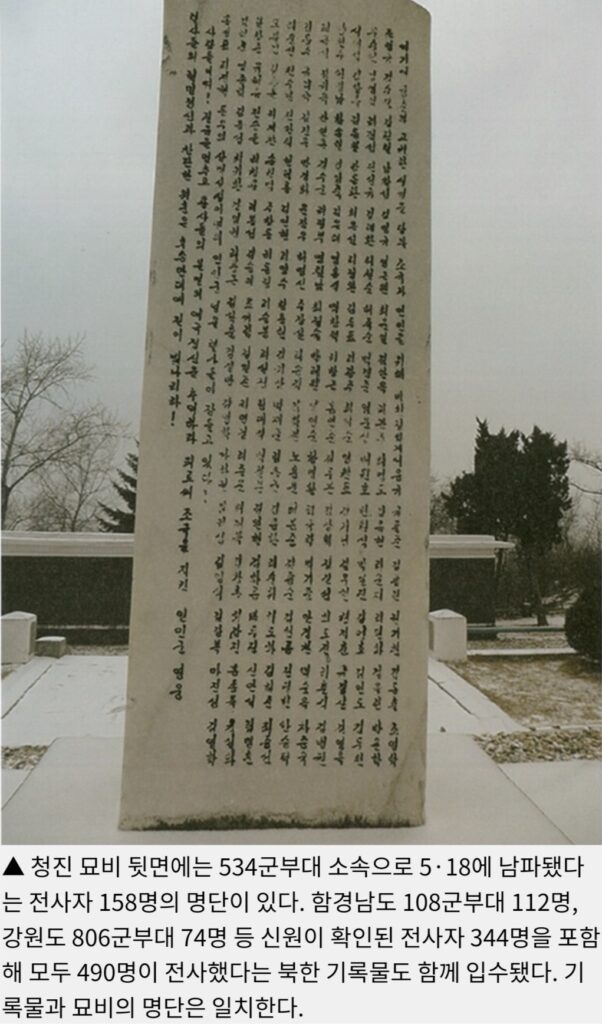
Above: On the backside of the Tombstone Monument in Chongjin is a list of 158 names of those in the 534th unit, who infiltrated South Korea and died during military operations / battles during the Gwangju incident. Also obtained [along with the photo of the monument] were documents showing a total of 490 battle deaths, including 112 from the 108th unit in South Hamkyung Province and 74 from the 806th unit in Gangwon Province. The names on the monument match those in the documents obtained.
There are mixed opinions about former director Kwon.
As Roh Tae-woo’s slush fund was exposed, there were suspicions that he (Kwon) played a role in relabeling the Gwangju incident from the Subversive Armed Insurrection (국가전복 무장 폭동) into a Democratization Movement (민주화 운동).
According to Dr. Michael Lee (91) (Ph.D. in Political Science from George Washington University), who investigated Korea’s turbulent modern history for 40 years at the CIA and other U.S. intelligence agencies, Kim Young-sam, who knew that Roh Tae-woo had misappropriated the proceeds from the sale of the Democratic Justice Party (민정당) training center, pressured Roh Tae-woo, and extorted ₩300 billion ($377 million in 1992 dollar; 1992 $1: ₩795; $964 million with cumulative South Korean inflation of 155.73% ) in political slush funds and even inherited the baton of the presidency.
Kim Young-sam turned from a member of the opposition party to a presidential candidate of the conservative Democratic Liberal Party (민자당) through the merger of the three political parties. Kim Yong-sam receiving political slush funds from Roh Tae-woo was exposed when National Assemblyman Park Gye-dong (박계동) revealed it. To quell the backlash from Honam [Jeolla Provinces region in southwest Korea, which was the support base for Kim Dae-jung, Kim young-sam’s political rival], which latched on to the scandal, Kim enacted the “Gwangju Democracy Movement Special Act” (광주민주화운동특별법). Dr. Lee directly hit back, saying, “The representative figures who cooperated to achieve this were Kwon Young-hae, the then NSP Director, and Hong Joon-pyo (the current mayor of Daegu and former presidential candidate).” <See this newspaper’s article on November 1, 2023 “[Exclusive: Seeking Truth about 5.18 [the Gwangju incident of May 1980] <21> ‘Political Power Rivalry is to Blame for Turning 5.18 into a Democratization Movement’.”
Against this backdrop, there has been an assessment that former NSP Director Kwon generally shares the same interests as those who view the Gwangju incident as a democratization movement. He has also been embroiled in various controversies, including a history of self-harm and being convicted of making false official documents.
However, former director Kwon’s statement in an interview with this newspaper stating that “our agents have personally checked” is noteworthy in that it is possible to cross-check.
In an anonymous interview with this newspaper in November last year, Mr. A, who was involved in the identification of the Tombstone Monument, suggested that “our staff” or “our line” went and checked it in person. He also revealed that the equipment used was a Samsung digital camera.
Specifically, after testifying that the “Counter-North Korea operations (HID),” a military intelligence unit of Korea Defense Intelligence Command (KDIC), was involved, he replied that the initial information about North Korea’s involvement in Gwangju in May 1980 was obtained from “NSP/KDIC materials.”
The explanation is that the NSP obtained the North Korean data, and the HID had repeatedly fact-checked the NSP obtained-data. This is consistent with the words of former director Kwon. This means that it can be cross-validated.
[Truncated]
When presented with IMINT (imagery intelligence) during the interview with Mr. A last year, this newspaper assessed that it is [genuine] on-site information. However, there was no way to cross-check, so it was classified as “intelligence information” and reporting on it was suspended.
The Names of 490 North Korean Operatives who Died while Conducting Sabotage Operations in South Korea are Inscribed on the Tombstone Monument in Chongjin
- It was erected 800 meters north of the Chongjin Station building on February 8, 1998.
- There are 2 records of the “battle dead” from the 534th, 108th, and 806th military units and their battle records
- Date of death of June 19, 1980…the deaths occurred on different dates, but used one date—the date the operation ended—as the death date for all.

Above: The names engraved on the Tombstone Monument match the list of battle-dead names that is managed by North Korea’s Ministry of State Security (MSS). It was written by hand initially, but North Korea digitized it in the mid-1990s.
With the revelations of the former NSP head, the existence of the Tombstone Monument in Cheongjin is being put in new light.
According to the Gwangju Incident Viewed from the Records of Intelligence Agencies of North Korea, South Korea, the United States, and Japan (북한과 한·미·일 정보기관의 기록물로 본 광주사태) (SaeDongA Seo, June 2020), which was published by the participants of the Chongjin Tombstone Monument Identification Project (청진 묘비 확인 프로젝트), the death toll of the North Korean military units that Kim Il-sung sent to South Korea for the Gwangju May 1980 operations totaled 490. This includes 344 confirmed deaths from the operations: 158 from the 534th unit, 112 from the 108th unit, and 74 from the 806th unit.
In the [Gwangju Incident Viewed from the Records of Intelligence Agencies of North Korea, South Korea, the United States, and Japan, it is written that] about 70 meters above sea level in Nagyang-dong, Cheongam District, Chongjin City, North Hamgyong Province (함경북도 청진시 청암 구역 낙양동), and about 800 meters north of Chongjin Station, is the “KPA Martyred Heroes Tombstone Monument (인민군 영웅들의 렬사비).” The Tombstone Monument, erected on February 8, 1998, bears the names of the battle dead. On the left side of the monument is written in red, “Erected on the eighth day of the second month in the year one thousand nine hundred and ninety-eight.”
The names on the Tombstone Monument and the names in two North Korean documents—the “Record of the Battle of the KPA Fighters for the Unification and Independence of the Fatherland (June 1980) who Died in Battles” and the “Records of the Fighters of the KPA Killed in the Struggle for the United Front of South Korea (August 1, 1980)”—match.
The battle record report is a record of the battle dead of the 534th, 108th, and 806th military units located in North Hamgyong Province, South Hamgyong Province, and Gangwon Province. Kim Kye-chol (김계철) and 15 other authors stated on page 26 of the book that the 534th military unit is the most elite unit of the North Korean army and is the successor of the 124th military unit that ambushed the Blue House during North Korea’s assassination attempt—“the Kim Shin-jo incident—in January 21, 1968 [North Korea sent 30+ commandos to South Korea to assassinate President Park Chung-hee and other South Korean officials at the Blue House in January 1968, and Kim Shin-jo was on the assassination team. He was the only one captured alive.]
According to these North Korean documents, each military unit under the Ministry of People’s Armed Forces of the KPA made a list of battle dead on August 1, 1980. The words “For the Party, the Leader, the Country, and the People” are written in gold at the top of the red cover, and the North Korean national emblem (the official emblem of North Korea) is placed in the center of the cover. The MSS maintains the list, the book states.
In the summer of 1980, when the list was being compiled, two temporary tombs were made separately, one for men and the other for women, but the North Korean authorities reportedly did not erect the Tombstone Monument initially in order to keep secret North Korea sending sabotage operators to South Korea for the Gwangju incident.
On page 118 of the book, Kim Kye-chul and other authors interpret that “when candidate Kim Dae-jung won the presidency in the 1997 elections, North Korea decided that what it had hidden was a success, so in 1998 it renovated the cemetery and erected the Tombstone Monument.”
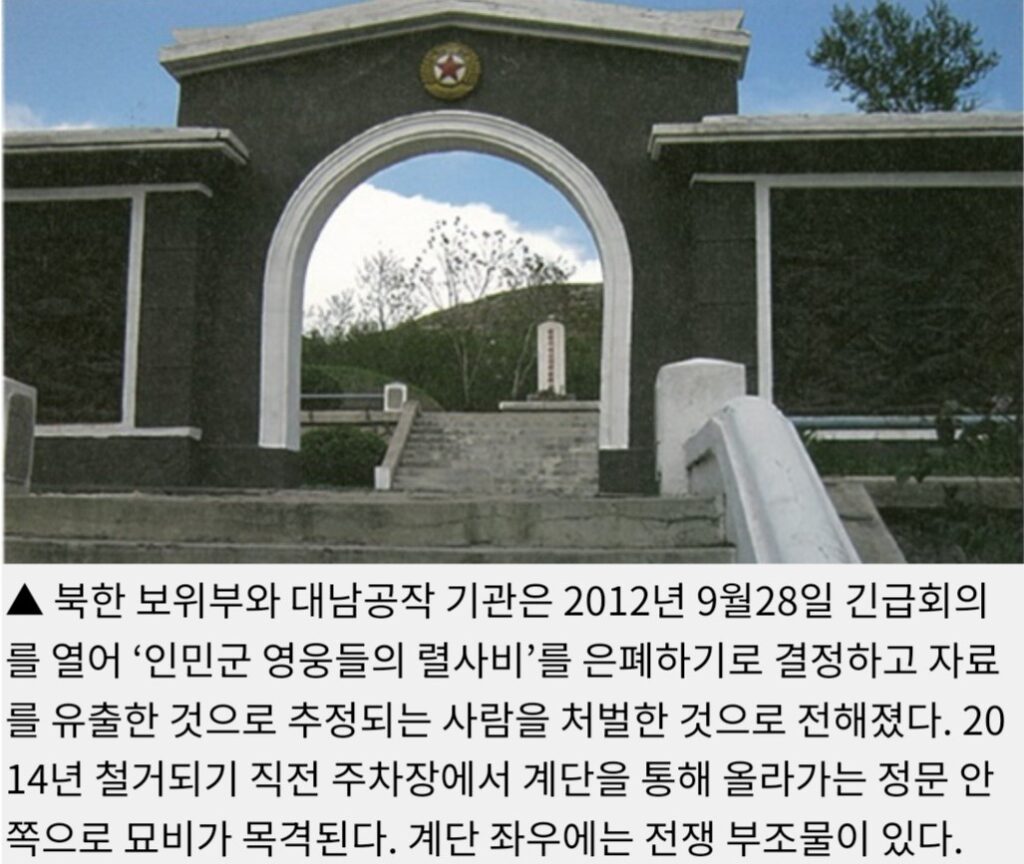
Above: North Korea’s MSS and Anti-South Korea Operations agencies held an emergency meeting on September 28, 2012 and decided to conceal the “KPA Martyred Heroes Tombstone Monument” and punished those who were suspected of leaking the reference materials. One can see the Tombstone Monument from the parking lot to the inside of the main entrance on top of the stairs before the monument was removed in 2014. On the left and right of the stairs are reliefs of the battle/fighting.
There were no bodies in the actual graves. They were temporary graves (가묘) made of hair and belongings [of the dead].
The date of death of all the military personnel whose names appear on the graves is the same: June 19, 1980. This date was known as the end date of North Korea’s Gwangju operations in 1980.
There is no information yet that a large-scale engagement or battle took place in North Korea in June 1980 in which 490 people were killed, including the 344 who have been identified. Because of this, the temporary graves have been constantly linked to the Gwangju incident since the first photo was released.
On September 27, 2012, when a group of North Korean defectors held a press conference in Seoul to reveal the identity of the graves and monuments, North Korea removed the Tombstone Monument over the course of 2013 and 2014 in order to hide it, and the site was disguised as a Korean War memorial, i.e., the KPA Heroes’ Cemetery, the book recorded. This occurred after 15 years since the Tombstone Monument was built.
It is said that even in 2014, it was also disguised as a grave decoration, leaving two graves intact and removing the Tombstone Monument somewhere in order to hide. Then, a new stele monument was erected by the central staircase, and the years 1950~1953 was added at the bottom front. This way, the graves of those who died in June 1980 suddenly turned into the graves of those who died in the Korean War.
The “KPA Martyred Heroes Tombstone Monument” (인민군 영웅들의 렬사묘비) contained a list of battle dead, but the “KPA Martyrs Tombstone” (인민군 렬사 묘비), which was renovated in 2013 and 2014, does not contain any names. In response to this, the authors said, “We can see that the situation is something that the North Korean authorities have to conceal,” and they agreed that it is “evidence of disguise.”

Above: North Korea constructed two separate temporary graves—one for men, the other for women. However, it was assessed that after the summer constructions was completed in 2015, the “KPA Martyred Heroes’ Tombstone Monument” was eliminated and disguised as a cemetery related to the Korean War. Its geographic coordinate is N 41° 47’ 54.03” E 129° 47’ 59.3” on Google Map.
In the North Korean documents containing the names of these battle dead, the names of others are also found.
The North Korean Unit 534 battle reports recorded that on September 11, 1975, it infiltrated Gochang, North Jeolla Province, and 14 people were killed. At that time, South Korean police commandos were deployed [to Gochang] and engaged in a skirmish; three South Korean police officers were killed. The battle record report lists the names of 14 battle dead, including Captain Choi Young-nam (최영남).
In June 1980, the North Korean espionage infiltration incident at the Imwol Bridge in Munsan, Gyeonggi Province, South Korea resulted in the death of four North Koreans, including KPA Major General Kang Chol-hwan (강철환 소좌), according to the 534th military unit’s combat record report. The South Korean government announced that it had cleared out three armed North Korean special operatives. The date of their death was March 23, 1980, so it is different (than the June 19, 1980 date). It is presumed that either our [South Korean government’s] announcement was wrong or that the North included the deaths during the exercises [prior to the actual sabotage operations].
Also found in North Korea’s battle record is the list of 13 KPA 534th unit’s special operatives killed, including KPA Major General Pak Chol (박철), during the North Korean submarine espionage incident at Gangneung (강릉), South Korea in September 1996. Separately, also discovered in the report was a list of 12 [infiltration boat] crew members. Eleven crew members were found dead, and a crew member Ri Kwang-su (이광수) was captured alive after a resident reported it to the authorities. The ROK military assessed that 13 of the 14 members of 534th Unit were killed while fleeing, and one escaped to the north by crossing over the Military Demarcation Line fence. This [North Korea’s report of 13 battle dead] is exactly the same as our military’s announcement of killing 13 armed North Korean special operatives. North Korea collectively recorded the date of their deaths as September 20, 1996.
Mr. A, who was involved in the work to identify the temporary graves, said, “Four people who were involved in the graves verification process were discovered by the MSS and died during the verification process,” and “those whose names are at the front of the co-authors of the book [Gwangju Incident Viewed from the Records of Intelligence Agencies of North Korea, South Korea, the United States, and Japan] are the contributors who lost their lives.”
[TRANSLATION]
Source: [단독] 권영해 “5·18 北 개입 안기부서 확인”
https://www.skyedaily.com/news/news_view.html?ID=236561
[5·18 진실 찾기㉟] YS정부 안기부장 충격적 폭로
[단독] 권영해 “5·18 北 개입 안기부서 확인”
1994~1998년 안기부 재직 때 비밀공작 통해 확인
“北 청진에 있는 ‘남파영웅 렬사묘’가 직접적 증거
南에 묘비 존재 들통나자 돌연 제3의 장소로 옮겨”
허겸 기자 기자페이지 + 입력 2024-06-20 20:00:01

▲ 북한 함경북도 청진에 있는 ‘인민군 영웅들의 렬사묘비’. 본지에 사진을 제공한 대북정보수집팀은 2011년 11월 촬영했다고 밝혔다.
국가안전기획부(現 국가정보원)가 북한의 5·18 광주사태 개입을 1990년대에 ‘비밀공작’을 통해 이미 확인한 사실이 처음으로 밝혀졌다.
권영해(87·權寧海·사진) 전 안기부장은 최근 스카이데일리와 만나 “정보기관장 재직 시절 북한의 5·18 개입을 우리 정부가 직접 확인했다”고 폭로했다.
북한의 광주사태 개입에 대해 전직 정보기관장이 확인 발언한 것은 이번이 처음이다.
1993년 국방부 장관에 이어 1994년부터 1998년까지 안기부장을 지낸 권 전 부장은 지금까지 ‘북한의 5·18 개입’을 증언한 정부 최고위직 인사다.

그는 김영삼정부와 김대중정부에 걸쳐 안기부장으로 재임했다. 이 기간은 5·18이 폭동에서 민주화운동으로 사회적 평가가 극명하게 뒤바뀔 무렵이었고, 김영삼정부가 증거를 조작하는 과정에 정보기관장으로서 권 전 부장도 가담했다는 의혹이 꾸준히 제기됐다.
이 때문에 이번 인터뷰는 그에겐 최초의 양심선언으로 평가된다.
그동안 권 전 안기부장에게 제기된 의혹과 시대적 분위기 탓에 그는 공개석상 또는 언론 인터뷰에서 5·18에 북한이 개입했는지 직접적으로 언급한 사실이 단 한 번도 없었다.
그러나 이번에 본지 인터뷰에서 현직 안기부장 재직 시절 북한의 광주사태 개입을 우리 요원들이 직접 확인한 사실을 처음으로 실토함에 따라 향후 추가 폭로에 나설지 그의 입에 관심이 집중되고 있다.
권 전 안기부장은 17일 서울 모처에서 열린 정당 행사 직후 기자와 만나 “현직 (안기부장) 시절 북한의 광주사태 개입을 비밀공작을 통해 내가 직접 확인했다”고 충격 폭로했다.
그는 당시 공작 방식과 경위에 대해선 “정보기관 고유 업무”라고 말을 아끼면서도 “북한 청진에 있는 (남파) 영웅들의 비석은 사실”이라고 구체적인 지형지물을 적시했다.
권 전 부장은 “(청진 비석의 존재가 남한에 알려지자) 위치를 바꾸고 제3의 장소로 숨겼다”면서 비석과 북한 광주 개입의 관련성에 대해 “사실이고 내가 확인한 것”이라고 거듭 부연했다. 제3의 장소는 북한 동북부는 아니다.
확인한 시점에 관해선 “내가 있을 때”라고 현직 정보기관장으로서 확인한 사실을 강조한 뒤 “북한 교과서에 나왔기 때문에 확인하려 한 것이었고 소스(source)는 구체적으로 밝힐 수 없다”고 여지를 남겼다.
그러면서 “북한 교과서에 (비석의 존재가) 나와서 청진에 있다는 것을 알고 우리가 확인에 나섰다”면서 “그러나 공작이기 때문에 그것을 (우리) 정보기관에서 확인했다는 말을 확인해 줄 수 없어 탈북자들이 제공한 것으로 그렇게 처리됐다”고 밝혔다.
당시 공작 결과를 대통령에게 보고했는지에 대해선 언급하지 않았다. 그의 임기 후반부는 국민의정부(DJ정부)와도 겹친다. 제15대 대통령 김대중은 1998년 2월25일 취임했고 권 전 안기부장은 그해 3월까지 재직했다.

▲ 청진 묘비 뒷면에는 534군부대 소속으로 5·18에 남파됐다는 전사자 158명의 명단이 있다. 함경남도 108군부대 112명, 강원도 806군부대 74명 등 신원이 확인된 전사자 344명을 포함해 모두 490명이 전사했다는 북한 기록물도 함께 입수됐다. 기록물과 묘비의 명단은 일치한다.
권 전 부장에 대해선 세간의 평가가 엇갈린다.
노태우의 비자금이 탄로 나면서 5·18이 국가전복 무장 폭동에서 민주화 운동으로 둔갑하는 과정에 그가 일익을 담당했다는 의혹도 받아왔다.
중앙정보국(CIA) 등 미국 정보기관에서 40년간 격동의 한국 현대사를 조사한 마이클 이(91) 박사(미 조지 워싱턴대·정치학)에 따르면 노태우가 민정당 연수원 매각 대금을 착복한 사실을 안 김영삼은 노태우를 압박해 정치자금 3000억 원을 뜯어내고 대권 바통까지 물려받았다.
3당 합당으로 재야인사에서 보수정당인 민자당 대선 후보로 변신한 김영삼은 집권 후 박계동 의원의 폭로로 노태우로부터 정치자금을 받은 사실이 들통나자, 스캔들을 물고 늘어지는 호남 세력의 반발을 잠재우기 위해 ‘광주민주화운동특별법’을 제정했다. 이 박사는 “이 일을 성사시키기 위해 협력한 대표적 인사가 당시 권영해 안기부장과 홍준표(현 대구시장)였다”고 직격했다. <본지 2023년 11월1일자 [단독: 5·18 진실 찾기] <21> “5·18이 민주화운동 된 건 정치권력 야합 탓” 보도 참조>
이런 배경 탓에 권 전 안기부장은 5·18을 민주화운동으로 보는 쪽과 대체로 이해관계를 같이 한다는 그동안의 평가가 있었다. 자해 소동과 허위공문서 작성 혐의로 유죄가 확정된 전력 등 각종 논란에 휩싸여온 인사이기도 하다.
그러나 권 전 부장이 본지 인터뷰에서 “우리 요원들이 직접 확인했다”고 한 발언은 크로스 체킹(cross checking·교차검증)이 가능하다는 점에서 주목된다.
청진 묘비의 확인 공작에 관여한 A씨는 지난해 11월 서울 모처에서 익명을 전제로 본지와 가진 인터뷰에서 “우리 직원” 또는 “우리 라인”이 직접 가서 확인했다고 확인 방식을 제시한 바 있다. 삼성 디지털 카메라를 사용했다고 장비에 대해서도 밝혔다.
구체적으로 ‘북파공작원(HID)’으로 불리는 군 첩보부대 국군정보사령부(정보사)가 관여했다고 증언한 데 이어 5·18 북한 개입 정보의 최초 입수 경위는 “안기부/정보사 자료”라고 답했다.
HID가 북한 현지에서 취득한 안기부 획득 자료를 기초로 북한 현지에서 팩트 체크를 거듭한 방식이라는 설명이다. 권 전 부장의 말과 일치한다. 교차 검증이 가능하다는 뜻이다.
대북 정보는 다양하게 취득하며 북한에서 협력하는 사람을 통한 휴민트(HUMINT·인간정보) 방식도 널리 사용되는 것으로 알려졌다. 따라서 “우리 요원들이 공작을 통해 확인했다”는 말은 권 전 부장이 이 과정에 직접 관여하지 않고선 알거나 섣불리 밝힐 수 없는 내용이다.
작년 A씨와 인터뷰 당시 본지는 이민트(IMINT·이미지 정보)를 제시한 만큼 현지 정보일 가능성은 매우 높다고 봤다. 하지만 교차 검증할 방법이 없어 ‘첩보’ 단계로 분류하고 이에 관한 보도를 유예하고 있었다.
청진 비석에 새겨진 北 남파공작 사망자 490명
1998년 2월8일 청진역 건물 북쪽 800m 떨어진 곳에 세워
534·108·806군 부대 ‘전사자’ 기록물·전투기록장 2건 존재
사망일 1980년 6월19일… 죽은 날 달라 작전 종료일로 통일

▲ 묘비 명단은 북한 보위부가 관리하는 전사자 명단과 일치한다. 수기로 쓴 옛 자료는 북한이 1990년대 중반에 전산화했다.
전직 안기부장의 폭로로 청진 묘비의 존재가 새롭게 조명받고 있다.
청진 묘비 확인 프로젝트 참여자들이 만든 ‘북한과 한·미·일 정보기관의 기록물로 본 광주사태(새동아서·2020년 6월 刊)’에 따르면 김일성이 5·18에 남파한 북한 군부대 사망자는 534군부대 158명, 108군부대 112명, 806군부대 74명 등 신원이 확인된 전사자 344명을 포함해 모두 490명이라고 기록돼 있다.
이 중 함경북도 청진시 청암 구역 낙양동 해발 약 70m 지점, 청진역 북쪽 약 800m 지점에는 ‘인민군 영웅들의 렬사비’가 있다. 1998년 2월8일 세워진 묘비에는 전사자 명단이 새겨 있다. 비석 왼쪽 옆에는 붉은색으로 ‘일천 구백 구십 팔년 이월 팔 일 세움’이라고 건립 날짜가 적혀 있다.
‘조국의 통일독립을 위한 인민군 전사들의 전투 기록장(1980년 6월)’과 ‘남조선 통일전선을 위한 투쟁에서 전사한 조선인민군 열사자료(1980년 8월1일)’ 등 2개의 북한 문건에 기재된 명단과 묘비의 명단은 일치한다.
전투 기록장은 함경북도·함경남도·강원도에 자리한 534·108·806군부대 전사자에 관한 기록이다. 김계철 외 15명의 저자는 책 26쪽에서 534군 부대는 북한군 최정예로 1968년 김신조 1.21사태 당시 청와대를 기습한 124군 부대의 후신이라고 밝혔다.
이들 북한 문건에 따르면 조선 인민군 무력부 소속 각 군부대는 1980년 8월1일자로 전사자 명단을 만들었다. 붉은 표지 상단에 ‘당과 수령과 조국과 인민을 위하여’라는 금색 글씨가 있고 표지 중앙에 북한 국장(國章·북한을 상징하는 공식 표장)이 있다. 보위부가 이 명단을 관리한다고 책은 기술했다.
명단 작성 시기인 1980년 여름에 남녀 별개로 가묘 두 기를 만들었지만 북한 당국은 광주사태 남파를 비밀로 하기 위해 처음에는 비석을 세우지 않았다고 한다.
김계철 등 저자들은 책 118쪽에서 ‘1997년 선거에서 김대중 후보가 대통령에 당선되자 북한은 자신들이 숨긴 것이 성공했다고 판단해 1998년 묘역도 새로 단장하고 비석도 세웠다’고 해석했다.

▲ 북한 보위부와 대남공작 기관은 2012년 9월28일 긴급회의를 열어 ‘인민군 영웅들의 렬사비’를 은폐하기로 결정하고 자료를 유출한 것으로 추정되는 사람을 처벌한 것으로 전해졌다. 2014년 철거되기 직전 주차장에서 계단을 통해 올라가는 정문 안쪽으로 묘비가 목격된다. 계단 좌우에는 전쟁 부조물이 있다.
실제 묘에는 시신은 없다. 머리털이나 소지품을 넣고 만든 가묘(假墓)다.
가묘에 이름이 적힌 전사자들의 사망 날짜는 모두 1980년 6월19일로 똑같다. 이날은 북한의 5·18 작전 종결일로 알려졌다.
신원이 확인된 344명을 비롯해 북한에서 490명이 전사한 대규모 교전 또는 전투가 1980년 6월에 있었다는 정보는 아직 없다. 이 때문에 가묘는 최초 사진이 공개된 이후부터 5·18 관련성이 끊임없이 나돌았다.
2012년 9월27일 탈북인 단체가 서울에서 기자회견을 열고 묘와 비석의 정체를 밝히자 묘비를 숨기기 위해 2013·2014년에 걸쳐 철거했고 6·25 전쟁 기념물, 즉 인민군 렬사묘로 위장했다고 책은 기록했다. 청진 렬사비가 세워진 지 15년 만이다.
2014년에도 묘 단장으로 위조해 묘 두 개는 그대로 두고 비석은 모처에 옮겨 숨겼다고 한다. 이어 중앙 계단이 있는 곳에 새로운 기념비를 세우고 앞면 하단에 1950~1953년이라는 숫자를 넣어 1980년 6월 사망자들의 가묘가 별안간 6·25 전쟁 전사자의 묘지로 변했다.
‘인민군 영웅들의 렬사 묘비’에는 전사자 명단이 있었지만 2013·2014년 새 단장을 마치고 세워진 ‘인민군 렬사 묘비’에는 명단이 없다. 이에 대해 저자들은 “북한 당국이 감춰야만 하는 상황임을 알 수 있다”며 ‘위장의 증거’라고 입을 모았다.

▲ 북한 당국은 1980년 여름에 남녀 별개로 가묘 두 개를 만들었지만 2014년 여름 공사가 끝난 뒤 ‘인민군 영웅들의 렬사비’를 제거하고 6·25 관련 묘지로 위장한 것으로 파악됐다. 구글 위치는 N 41° 47′ 54.03” E 129° 47′ 59.3”
이들 전사자 명단이 든 북한 문건에는 또 다른 전사자들의 명단도 발견된다.
북한 534부대 전투 기록장에는 1975년 9월11일 전북 고창에 침투해 14명이 사살됐다고 기록됐다. 당시 경찰특공대가 투입돼 교전을 벌이다 우리 경정 3명이 숨졌다. 전투 기록장은 최영남 대위 등 전사자 14명의 명단을 기재하고 있다.
1980년 6월 경기 문산 임월교 간첩 침투 사건은 강철환 소좌 등 4명이 전사한 것으로 534군부대 전투기록장은 기록했다. 정부는 무장 공비 3명을 소탕한 것으로 발표했다. 전사 일은 3월23일로 다르다. 우리 발표가 틀렸거나 북측이 훈련 중 사망자를 포함한 것으로 추정된다.
1996년 9월 강릉 잠수함 간첩침투 사건 당시 박철 소좌 등 북한군 534부대 전사자 13명 명단도 전투 기록장에서 발견된다. 이와 별도로 승조원 12명의 명단도 있다고 책은 밝혔다. 승조원 11명은 숨진 채 발견됐고 승조원 이광수는 주민 신고로 생포됐다. 534부대원 14명 중 13명은 도주 중 사살됐고 1명은 휴전선 철책을 넘어 북으로 도주한 것으로 우리 군은 파악하고 있다. 공비 13명을 사살했다고 발표한 우리 군과 정확하게 일치한다. 북한은 이들의 전사 일을 일괄적으로 9월20일로 기록했다.
가묘 확인 공작에 관여한 A씨는 “확인 과정에서 4명이 보위부에 발각돼 숨졌다”며 “공동저자 중 맨 앞에 이름이 있는 이들이 목숨을 잃은 공로자들”이라고 밝혔다.
허겸 기자 kh@skyedaily.com

